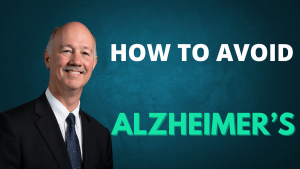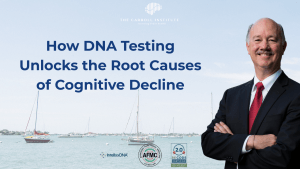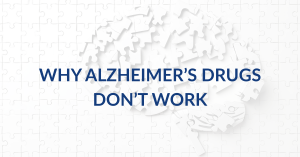Last Updated: October 2025
Modern neuroscience continues to confirm that the brain can repair itself—if given the right tools. At The Carroll Institute in Sarasota, Dr. Garland Glenn, DC, PhD, AFMC, uses advanced neurotechnology to stimulate brain repair and strengthen neural communication. Two of the most innovative methods are photobiomodulation therapy and sensorimotor integration (SMI) therapy. Together, they help patients improve focus, balance, and memory by rebuilding the neural pathways that control these functions. For a broader overview of our approach, see Functional Neurology: Retraining the Brain for Cognitive Health.
These therapies are integrated into Sarasota’s only Functional Neurology and ReCODE-certified program—helping patients reverse or prevent cognitive decline, post-COVID brain fog, and neurodegenerative conditions. To learn how these tools appear in real care plans, visit What Happens During a Functional Neurology Session?
What Is Photobiomodulation Therapy?
Photobiomodulation (PBM) uses specific wavelengths of red and near-infrared light to improve brain oxygenation, blood flow, and mitochondrial energy production. This process enhances the brain’s natural ability to heal and form new neural connections—known as neuroplasticity (NIH, 2011; NIH, 2022).
At The Carroll Institute, Dr. Glenn uses the Neuronic Photobiomodulation Helmet—a medical-grade system that delivers gentle light pulses directly through the skull to reach the cortex. Studies show this technique increases regional cerebral blood flow and oxygenation while activating key metabolic pathways in neurons (Science Advances, 2022).
By energizing brain cells, PBM therapy supports improved memory, clarity, and focus. It also helps reduce neuroinflammation—one of the hidden drivers of cognitive decline and neurodegeneration. To see where PBM fits in your journey, start with What to Expect During a Functional Neurology Exam.
How Photobiomodulation Helps Rebuild Brain Pathways
- Boosts Cellular Energy (ATP): Improves neuron metabolism for faster communication.
- Increases Blood Flow and Oxygen: Enhances delivery of vital nutrients and oxygen to brain tissue.
- Stimulates Neurogenesis: Encourages the growth of new neurons and synaptic connections.
- Reduces Neuroinflammation: Calms overactive immune responses that damage brain tissue.
When used before neurocognitive exercises, photobiomodulation “primes” the brain—creating an ideal environment for learning and repair. For more on how the brain rewires after injury, see Can the Brain Rewire Itself After Injury?
What Is Sensorimotor Integration Therapy?
Sensorimotor Integration (SMI) therapy helps the brain relearn how to process and respond to sensory input. It focuses on improving the way the brain integrates visual, auditory, and motor information—critical for balance, attention, and spatial awareness (RKB Instruments).
The Carroll Institute uses the Neurosensory Motor Integrator (SMI), developed by RKB Instruments. This system combines visual targets, light, and sound to engage specific brain regions. It helps synchronize eye movements, reaction time, and motor control—essential for restoring focus and coordination after brain injury or cognitive decline.
How the SMI Strengthens Brain Circuits
- Visual-Motor Reconnection: Retrains coordination between the eyes, hands, and movement systems (see Tachistoscope and Saccades training).
- Improved Attention & Processing Speed: Enhances reaction time and executive function.
- Multisensory Integration: Strengthens how the brain interprets combined visual and auditory signals—key for reading, driving, and multitasking (explore why balance, coordination, and eye movements reveal brain health).
- Enhanced Neuroplasticity: Encourages communication between the cerebellum, prefrontal cortex, and sensory networks.
SMI therapy helps patients regain control, balance, and attention by reestablishing lost connections between sensory input and motor response. For many, this translates into clearer thinking, steadier walking, and better reading or memory recall.
Combining PBM and SMI for Maximum Neuroplasticity
When used together, the Neuronic Photobiomodulation Helmet and the Neurosensory Motor Integrator provide a twofold advantage: PBM energizes the brain’s metabolic systems, while SMI retrains its communication networks. This dual approach helps the brain not only heal but perform better than before. See how this translates to Alzheimer’s care in How Functional Neurology Helps Alzheimer’s Disease.
Dr. Glenn often combines these technologies with ReCODE-based metabolic therapy to correct the underlying biochemical imbalances that block brain recovery. This synergy of light, motion, and metabolism creates a truly comprehensive model for brain restoration.
Who Benefits From These Therapies?
- Early cognitive decline or memory loss (MCI, Alzheimer’s)
- Post-COVID brain fog or fatigue
- Concussion or traumatic brain injury
- Balance disorders or dizziness
- Focus, reading, or attention challenges
To learn how we evaluate your brain networks before therapy, see What to Expect During a Functional Neurology Exam. To understand how these tools are integrated into care, visit What Happens During a Functional Neurology Session?
Take the Next Step Toward Brain Repair
If you’re struggling with memory, focus, or balance, there’s hope. Book a Discovery Call with The Carroll Institute to learn how our advanced neurorehabilitation programs can help your brain heal from the inside out.
Sources
- Neuronic Photobiomodulation Helmet — Neuronic
- Transcranial Photobiomodulation Increases Cognition — Science Advances (2022)
- Photobiomodulation Improves Cerebral Blood Flow — NIH / PubMed (2011)
- Photobiomodulation and Cognitive Enhancement — NIH / PubMed (2022)
- Neurosensory Motor Integrator (SMI) — RKB Instruments; Tachistoscope; Saccades Training
- Functional Neurology Overview — The Carroll Institute
- Precision Medicine Approach to Alzheimer’s Disease — Journal of Alzheimer’s Disease Reports (2023)
Medically reviewed by Dr. Garland Glenn, DC, PhD, AFMC (Advanced Functional Medicine Clinician)
The Carroll Institute — Sarasota, FL
Learn more about Dr. Glenn’s background and credentials: About Dr. Garland Glenn
This content is for educational purposes only and is not a substitute for personalized medical advice.

Dr. Garland Glenn, DC, PhD, IFM, AFMC
Founder & Clinical Director, The Carroll Institute — Sarasota, FL
Dr. Garland Glenn is a board-certified chiropractic physician and functional medicine practitioner specializing in cognitive health, neurodegeneration, and root-cause medicine. Certified as an AFMC (Advanced Functional Medicine Clinician) and Institute for Functional Medicine (IFM) trained, he has also completed over 500 hours of advanced training in Functional Neurology under Dr. Ted Carrick, founder of the Carrick Institute.
At The Carroll Institute, Dr. Glenn leads Sarasota’s only ReCODE-certified Functional Neurology program, helping patients reverse or prevent cognitive decline through the Bredesen ReCODE Protocol, neuroplasticity exercises, and personalized functional medicine care.
Learn more about his background and approach at About Dr. Garland Glenn.
– schedule now –
free discovery call
To help you get started, we offer a free 20-minute Discovery Phone Consultation. During this call, you will be able to talk with one of our Certified Brain Health Coaches about what going on with you or your loved one and find out if we can help. Please review our FAQs prior to scheduling your free call. We look forward to talking with you soon and helping you Save Your Brain.
(yes, it’s totally free!)
ReCODE® is a registered program developed by Dr. Dale Bredesen and licensed through Apollo Health. Dr. Garland Glenn is a certified ReCODE practitioner.



